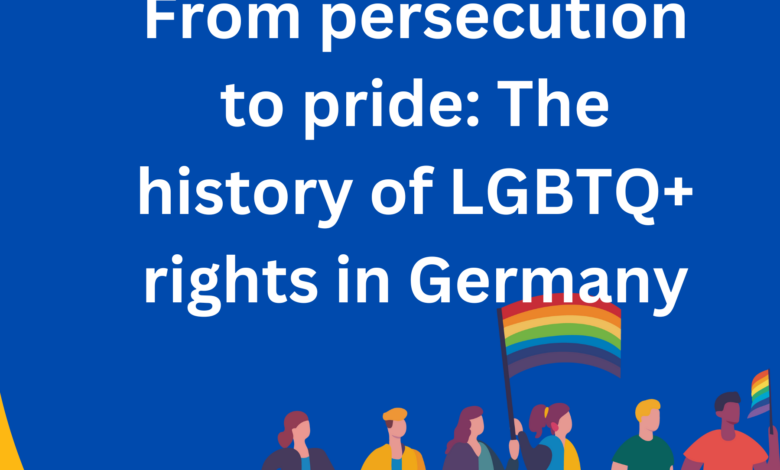From persecution to pride: The history of LGBTQ+ rights in Germany

From persecution to pride: The history of LGBTQ+ rights in Germany
LGBTQ+ rights in Germany has history has seen significant advancements since the inception of Pride celebrations in 1979. Inspired by the Stonewall riots, Bernd Gaiser and the LGBT community in Berlin initiated the first Pride events in Germany. Over time, Pride grew in importance. The movement expanded further after the legalization of homosexuality in the US in 1994. Today, Pride is celebrated in various German cities, serving as a reminder of the ongoing fight for LGBTQ+ rights.
The Start of a protest movement?
-
- Public campaigners in the German Empire laid the groundwork for LGBT rights in the 1800s.
- Karl Heinrich Ulrich advocated gay rights at the Congress of German Jurists in 1867, seeking to repeal Paragraph 175, which criminalized sodomy in 1871.
- Marcus Hirschfeld coined “cross-dresser,” opposed Paragraph 175, and founded the Scientific Humanitarian Committee to research and combat discrimination against individuals with same-sex attractions.
- Homosexuality wasn’t widely accepted, but few arrests were made under Paragraph 175 during the Empire’s rule.
The “Golden Age”
-
- Weimar Germany saw explosive cultural development despite challenges.
- Berlin had over 80 gay pubs, forming a well-known gay subculture.
- LGBT magazine “Die Freundin” thrived in Berlin from 1924-1933.
- The growing gay scene led to the first gay rights protest in 1922.
- Article 175 criminalized homosexuality, but some acceptance of gay culture emerged.
- Enforcement of paragraph 175 was lenient, resulting in minimal prosecution for suspected individuals with same-sex attractions.
A negative turn
-
- After the Nazis’ rise to power in 1933, the LGBT community in Germany faced severe persecution, with their organizations outlawed, and Paragraph 175 expanded in 1935.
- The “gay Holocaust” or “Homocaust” is an often neglected aspect of Nazi atrocities, where individuals with same-sex attractions were considered “degenerate” and encountered intense homophobia.
- Gay prisoners in concentration camps endured horrific medical experiments, aiming to “cure” their homosexuality.
- Research suggests up to 15,000 people with same-sex attractions were sent to concentration camps, with a potential death toll of up to 60%.
Liberal for Queer
Since women were typically never permitted to hold positions of authority and influence, the Third Reich did not actively target lesbians as a threat to societal order. This is not to suggest that lesbians led idyllic lives under the Third Reich; there are records of some lesbian prisoners in concentration camps, and openly gay women would not have had it easy in the Third Reich’s sociocultural environment.
Reluctant Acknowledgment
-
- The LGBT community is less acknowledged in Holocaust memorials and government policies compared to other oppressed groups.
- Dachau camp sculpture lacks the pink triangle for individuals with same-sex attractions, excluded in 1968 from “acknowledged” persecuted groups.
- Similar exclusions at other memorials highlight ongoing persecution and marginalization of the LGBT community.
- Exclusion from memorials was common, reflecting ongoing mistreatment.
- Homosexual survivors faced societal mistreatment, being treated as regular criminals.
- Many with same-sex attractions were imprisoned and died before government recognition of their suffering.
- In 2002, the German government agreed to compensate those harmed by paragraph 175.
- Compensation was officially extended to post-World War II charges only two years ago.
East and West
-
- Contrary to popular belief, the East German government was relatively more liberal regarding LGBT rights, despite censorship and widespread surveillance by the Stasi.
- The East German administration removed the Nazi alterations to paragraph 175, unlike their West German counterparts.
- Between 1949 and 1968, East Germany convicted almost 4,000 men under the Act, while West Germany convicted around 50,000 men for homosexuality between 1949 and 1969.
- In West Germany, 3,500 men were found guilty before the statute was eventually repealed in 1994, even after the removal of Nazi amendments in 1969.
Eastern Equality?
-
- East Germany’s LGBT advancements didn’t eradicate homophobia but addressed past persecution and gained support from some opposing socialism.
- It wasn’t a haven for individuals with same-sex attractions, as depicted in the documentary “Out in East Berlin.”
- Homophobia persisted despite legislative changes, and the Stasi monitored LGBT activities.
Political Development LGBTQ+ Rights in Germany
-
- Progress towards promoting gay rights in Germany is relatively recent.
- Bitterness surrounds the 2017 decision to legalize same-sex unions due to Angela Merkel’s opposition.
- Berlin’s first openly gay mayor, Klaus Wowereit, was well-known.
- The conservative CSU and CDU have often been hesitant towards liberal legislation.
- Challenges persist for homosexual couples seeking to adopt.
- Attacks against gay couples in Germany are on the rise, highlighting ongoing dangers for the LGBTQ+ community.
Future Liberation in LGBTQ+ Rights in Germany
-
- Germany’s LGBTQ+ history offers valuable lessons, showing that progress is not always linear and can be reversed, especially during economic downturns.
- Many countries still forbid homosexuality, highlighting the importance of Pride’s colourful protest and celebration.
- Germany’s Pride events aim to raise awareness of the ongoing fight for rights, both within and beyond the country.
Read more at How To Abroad:
Want to study in Germany? How To Abroad can help you achieve your academic dream
